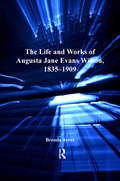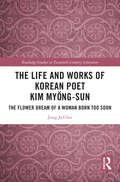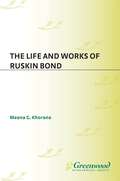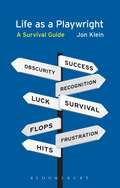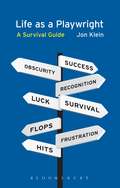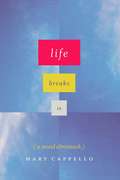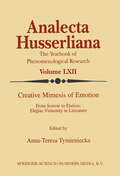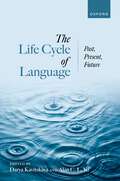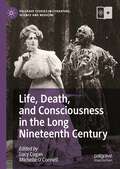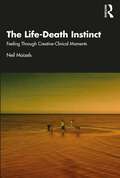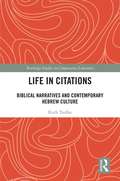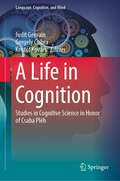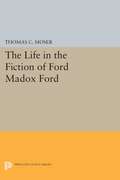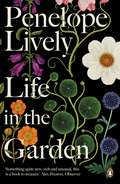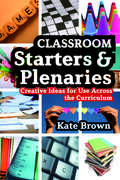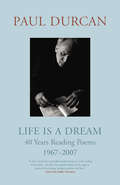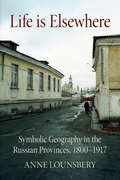- Table View
- List View
The Life and Works of Augusta Jane Evans Wilson, 1835-1909
by Brenda AyresOver the course of her 57-year career, Augusta Jane Evans Wilson published nine best-selling novels, but her significant contributions to American literature have until recently gone largely unrecognized. Brenda Ayres, in her long overdue critical biography of the novelist once referred to as the 'first Southern woman to enter the field of American letters,' credits the importance of Wilson's novels for their portrait of nineteenth-century America. As Ayres reminds us, the nineteenth-century American book market was dominated by women writers and women readers, a fact still to some extent obscured by the make-up of the literary canon. In placing Wilson's novels firmly within their historical context, Ayres commemorates Wilson as both a storyteller and maker of American history. Proceeding chronologically, Ayres devotes a chapter to each of Wilson's novels, showing how her views on Catholicism, the South, the Civil War, male authority, domesticity, Reconstruction, and race were both informed by and resistant to the turbulent times in which she lived. This comprehensive and meticulously researched biography contributes not only to our appreciation of Wilson's work, but also to her importance as a figure for understanding women's roles in history and their art, evolving gender roles, and the complicated status of women writers.
The Life and Works of Augusta Jane Evans Wilson, 1835-1909
by Brenda AyresOver the course of her 57-year career, Augusta Jane Evans Wilson published nine best-selling novels, but her significant contributions to American literature have until recently gone largely unrecognized. Brenda Ayres, in her long overdue critical biography of the novelist once referred to as the 'first Southern woman to enter the field of American letters,' credits the importance of Wilson's novels for their portrait of nineteenth-century America. As Ayres reminds us, the nineteenth-century American book market was dominated by women writers and women readers, a fact still to some extent obscured by the make-up of the literary canon. In placing Wilson's novels firmly within their historical context, Ayres commemorates Wilson as both a storyteller and maker of American history. Proceeding chronologically, Ayres devotes a chapter to each of Wilson's novels, showing how her views on Catholicism, the South, the Civil War, male authority, domesticity, Reconstruction, and race were both informed by and resistant to the turbulent times in which she lived. This comprehensive and meticulously researched biography contributes not only to our appreciation of Wilson's work, but also to her importance as a figure for understanding women's roles in history and their art, evolving gender roles, and the complicated status of women writers.
The Life and Works of Korean Poet Kim Myŏng-sun: The Flower Dream of a Woman Born Too Soon (Routledge Studies in Twentieth-Century Literature)
by Jung Ja ChoiThe Life and Works of Korean Poet Kim Myŏng-sun offers an introduction to Korea’s first modern woman writer to publish a collection of creative works, Kim Myŏng-sun (1896–ca. 1954). Despite attempts by male contemporaries to assassinate her character, Kim was an outspoken writer and an early feminist, confronting patriarchal Korean society in essays, plays, poems, and short stories. This volume is the first to offer a detailed analysis in English of Kim’s poetry. The poems examined in this volume can be considered early twentieth-century versions of #MeToo literature, mirroring the harrowing account of her sexual assault, and also subversive challenges to traditional institutions, dealing with themes such as romantic free love, same-sex love, single womanhood, and explicit female desire and passion. The Life and Works of Korean Poet Kim Myŏng-sun restores a long-neglected woman writer to her rightful place in the history of Korean literature, shedding light on the complexity of women’s lives in Korea and contributing to the growing interest in modern Korean women’s literature in the West.
The Life and Works of Korean Poet Kim Myŏng-sun: The Flower Dream of a Woman Born Too Soon (Routledge Studies in Twentieth-Century Literature)
by Jung Ja ChoiThe Life and Works of Korean Poet Kim Myŏng-sun offers an introduction to Korea’s first modern woman writer to publish a collection of creative works, Kim Myŏng-sun (1896–ca. 1954). Despite attempts by male contemporaries to assassinate her character, Kim was an outspoken writer and an early feminist, confronting patriarchal Korean society in essays, plays, poems, and short stories. This volume is the first to offer a detailed analysis in English of Kim’s poetry. The poems examined in this volume can be considered early twentieth-century versions of #MeToo literature, mirroring the harrowing account of her sexual assault, and also subversive challenges to traditional institutions, dealing with themes such as romantic free love, same-sex love, single womanhood, and explicit female desire and passion. The Life and Works of Korean Poet Kim Myŏng-sun restores a long-neglected woman writer to her rightful place in the history of Korean literature, shedding light on the complexity of women’s lives in Korea and contributing to the growing interest in modern Korean women’s literature in the West.
The Life and Works of Ruskin Bond (Contributions to the Study of World Literature)
by Meena KhoranaRuskin Bond is known internationally as one of India's most prolific writers in English for children, young adults, and adults. This literary biography analyzes the impact of personal, social, geographical, political, and literary influences on Bond's worldview, aesthetic principles, and writings. Connecting the development of Bond's writing career over the past 50 years to the evolution of the publishing industry in India, Khorana details the author's pioneering work in the field of children's and young adult literature, and his contribution to diasporic and postcolonial/post-independence literatures. She concludes that it is Bond's versatile, original, and elegant writing in a variety of genres that continue to endear him to readers around the world.According to the author, despite Bond's British background, he does not write about India from a Eurocentric perspective. Having lived the majority of his life in India, he knows the country as an insider, writing with an authenticity and emotional engagement about the land and the people of the Himalayas and small-town India. Khorana analyzes his novels and short stores, and highlights his juxtaposition of his protagonists' individual dramas against larger social, moral, and metaphysical issues. In addition, she reveals how the autobiographical and regional elements in Bond's work provide insight into universal themes such as the tension between past and present, city life versus rural values, the dignity of ordinary folk, preservation of the environment, and living in harmony with nature.
Life as a Playwright: A Survival Guide
by Jon KleinAddressing the questions central to any playwright's career and identity, Jon Klein offers you a glimpse into a career writing for the theatre. As well as an account of the day-to-day life of a writer, he also discusses what an aspiring playwright should expect as they navigate the industry and how to make yourself stand out from the crowd. Furthermore, the book looks at situations that the emerging playwright is likely to encounter, including: handling rehearsals, workshops, castings, re-writing, venues, reviews, successes and failure. The book concludes with seventeen interviews with other USA-based playwrights, representing a wide range of experience, from writers just starting to make a name for themselves to seasoned, award-winning veterans such as Sheila Callaghan, Steven Dietz, Keith Glover, Lauren Gunderson, John Pielmeier and Jen Silverman. Author Jon Klein has a wealth of experience with over 30 of his plays produced in the USA and over 100 productions, including include T Bone N Weasel, Dimly Perceived Threats to the System, Betty the Yeti, and his most recent play, Resolving Hedda. Klein draws upon the lessons he has learned from his associations with numerous established theatre folk, many from the start of their careers. These include figures such as Bob Falls, Gregory Hines, Jon Jory, Kenny Leon, Dan Sullivan, and August Wilson.clude figures such as Bob Falls, Gregory Hines, Jon Jory, Kenny Leon, Dan Sullivan, and August Wilson.
Life as a Playwright: A Survival Guide
by Jon KleinAddressing the questions central to any playwright's career and identity, Jon Klein offers you a glimpse into a career writing for the theatre. As well as an account of the day-to-day life of a writer, he also discusses what an aspiring playwright should expect as they navigate the industry and how to make yourself stand out from the crowd. Furthermore, the book looks at situations that the emerging playwright is likely to encounter, including: handling rehearsals, workshops, castings, re-writing, venues, reviews, successes and failure. The book concludes with seventeen interviews with other USA-based playwrights, representing a wide range of experience, from writers just starting to make a name for themselves to seasoned, award-winning veterans such as Sheila Callaghan, Steven Dietz, Keith Glover, Lauren Gunderson, John Pielmeier and Jen Silverman. Author Jon Klein has a wealth of experience with over 30 of his plays produced in the USA and over 100 productions, including include T Bone N Weasel, Dimly Perceived Threats to the System, Betty the Yeti, and his most recent play, Resolving Hedda. Klein draws upon the lessons he has learned from his associations with numerous established theatre folk, many from the start of their careers. These include figures such as Bob Falls, Gregory Hines, Jon Jory, Kenny Leon, Dan Sullivan, and August Wilson.clude figures such as Bob Falls, Gregory Hines, Jon Jory, Kenny Leon, Dan Sullivan, and August Wilson.
Life as Creative Constraint: Autobiography and the Oulipo (Contemporary French and Francophone Cultures #76)
by Anna KempLife as Creative Constraint is the first book to focus on the extraordinary life-writing of the French experimental writing group, the Oulipo. The Oulipo's enthusiasm for literary games and formal gymnastics has seen its work caricatured as 'lifeless' - impressively virtuoso but more interested in form than content and ultimately disengaged from the world. This book examines a broad corpus of work by Georges Perec, Marcel Bénabou, Jacques Roubaud and Anne F. Garréta to show that, despite the group's early devotion to the radical impersonality of mathematics, later generations of oulipians have brought the group's fascination with systems, games and constraints to bear on autobiography. Far from being 'lifeless', oulipian constraints and concepts provide the tools that allow writers to engage critically and creatively with lived experience, and mine the potential of the autobiographical genre. The games played by these writers are not simply pastimes or cunning writing techniques, but modes of survival, self-examination, self-invention, and relating to the world and to others. As the title of Georges Perec’s masterpiece suggests, they are a mode d’emploi for life.
Life Breaks In: A Mood Almanack
by Mary Cappello Rosamond PurcellSome books start at point A, take you by the hand, and carefully walk you to point B, and on and on. This is not one of those books. This book is about mood, and how it works in and with us as complicated, imperfectly self-knowing beings existing in a world that impinges and infringes on us, but also regularly suffuses us with beauty and joy and wonder. You don’t write that book as a linear progression—you write it as a living, breathing, richly associative, and, crucially, active, investigation. Or at least you do if you’re as smart and inventive as Mary Cappello. What is a mood? How do we think about and understand and describe moods and their endless shadings? What do they do to and for us, and how can we actively generate or alter them? These are all questions Cappello takes up as she explores mood in all its manifestations: we travel with her from the childhood tables of “arts and crafts” to mood rooms and reading rooms, forgotten natural history museums and 3-D View-Master fairytale tableaux; from the shifting palette of clouds and weather to the music that defines us and the voices that carry us. The result is a book as brilliantly unclassifiable as mood itself, blue and green and bright and beautiful, funny and sympathetic, as powerfully investigative as it is richly contemplative. “I’m one of those people who mistrusts a really good mood,” Cappello writes early on. If that made you nod in recognition, well, maybe you’re one of Mary Cappello’s people; you owe it to yourself to crack Life Breaks In and see for sure.
Life Breaks In: A Mood Almanack
by Mary Cappello Rosamond PurcellSome books start at point A, take you by the hand, and carefully walk you to point B, and on and on. This is not one of those books. This book is about mood, and how it works in and with us as complicated, imperfectly self-knowing beings existing in a world that impinges and infringes on us, but also regularly suffuses us with beauty and joy and wonder. You don’t write that book as a linear progression—you write it as a living, breathing, richly associative, and, crucially, active, investigation. Or at least you do if you’re as smart and inventive as Mary Cappello. What is a mood? How do we think about and understand and describe moods and their endless shadings? What do they do to and for us, and how can we actively generate or alter them? These are all questions Cappello takes up as she explores mood in all its manifestations: we travel with her from the childhood tables of “arts and crafts” to mood rooms and reading rooms, forgotten natural history museums and 3-D View-Master fairytale tableaux; from the shifting palette of clouds and weather to the music that defines us and the voices that carry us. The result is a book as brilliantly unclassifiable as mood itself, blue and green and bright and beautiful, funny and sympathetic, as powerfully investigative as it is richly contemplative. “I’m one of those people who mistrusts a really good mood,” Cappello writes early on. If that made you nod in recognition, well, maybe you’re one of Mary Cappello’s people; you owe it to yourself to crack Life Breaks In and see for sure.
Life Breaks In: A Mood Almanack
by Mary Cappello Rosamond PurcellSome books start at point A, take you by the hand, and carefully walk you to point B, and on and on. This is not one of those books. This book is about mood, and how it works in and with us as complicated, imperfectly self-knowing beings existing in a world that impinges and infringes on us, but also regularly suffuses us with beauty and joy and wonder. You don’t write that book as a linear progression—you write it as a living, breathing, richly associative, and, crucially, active, investigation. Or at least you do if you’re as smart and inventive as Mary Cappello. What is a mood? How do we think about and understand and describe moods and their endless shadings? What do they do to and for us, and how can we actively generate or alter them? These are all questions Cappello takes up as she explores mood in all its manifestations: we travel with her from the childhood tables of “arts and crafts” to mood rooms and reading rooms, forgotten natural history museums and 3-D View-Master fairytale tableaux; from the shifting palette of clouds and weather to the music that defines us and the voices that carry us. The result is a book as brilliantly unclassifiable as mood itself, blue and green and bright and beautiful, funny and sympathetic, as powerfully investigative as it is richly contemplative. “I’m one of those people who mistrusts a really good mood,” Cappello writes early on. If that made you nod in recognition, well, maybe you’re one of Mary Cappello’s people; you owe it to yourself to crack Life Breaks In and see for sure.
Life Breaks In: A Mood Almanack
by Mary Cappello Rosamond PurcellSome books start at point A, take you by the hand, and carefully walk you to point B, and on and on. This is not one of those books. This book is about mood, and how it works in and with us as complicated, imperfectly self-knowing beings existing in a world that impinges and infringes on us, but also regularly suffuses us with beauty and joy and wonder. You don’t write that book as a linear progression—you write it as a living, breathing, richly associative, and, crucially, active, investigation. Or at least you do if you’re as smart and inventive as Mary Cappello. What is a mood? How do we think about and understand and describe moods and their endless shadings? What do they do to and for us, and how can we actively generate or alter them? These are all questions Cappello takes up as she explores mood in all its manifestations: we travel with her from the childhood tables of “arts and crafts” to mood rooms and reading rooms, forgotten natural history museums and 3-D View-Master fairytale tableaux; from the shifting palette of clouds and weather to the music that defines us and the voices that carry us. The result is a book as brilliantly unclassifiable as mood itself, blue and green and bright and beautiful, funny and sympathetic, as powerfully investigative as it is richly contemplative. “I’m one of those people who mistrusts a really good mood,” Cappello writes early on. If that made you nod in recognition, well, maybe you’re one of Mary Cappello’s people; you owe it to yourself to crack Life Breaks In and see for sure.
Life Creative Mimesis of Emotion: From Sorrow to Elation: Elegiac Virtuosity in Literature (Analecta Husserliana #62)
by Anna-TeresaTymienieckaThe Life Cycle of Language: Past, Present, and Future
This volume brings together an international group of linguists from a diverse range of research backgrounds to explore the cycles of change in the world's languages. Historical linguistics does not solely focus on reconstructing a language's linguistic past and exploring the mechanisms underlying previous language changes; it also addresses broader questions concerning the development and ongoing evolution of language. The chapters in this book draw on data both from languages from the distant past, such as Hittite, Proto-Turkic, and Proto-Bantu, and from present-day languages including Akan, Cantonese, Kuuk Thaayorre, Seliš-Ql'ispé, Nivaclé, and Spanish. The contributions showcase current research in historical linguistics and exemplify the dynamism and inherently interdisciplinary nature of the field.
Life, Death, and Consciousness in the Long Nineteenth Century (Palgrave Studies in Literature, Science and Medicine)
by Lucy Cogan Michelle O’ConnellThis book explores how the writers, poets, thinkers, historians, scientists, dilettantes and frauds of the long-nineteenth century addressed the “limit cases” regarding human existence that medicine continuously uncovered as it stretched the boundaries of knowledge. These cases cast troubling and distorted shadows on the culture, throwing into relief the values, vested interests, and power relations regarding the construction of embodied life and consciousness that underpinned the understanding of what it was to be alive in the long nineteenth century. Ranging over a period from the mid-eighteenth century through to the first decade of the twentieth century—an era that has been called the ‘Age of Science’—the essays collected here consider the cultural ripple effects of those previously unimaginable revolutions in science and medicine on humanity’s understanding of being.
The Life-Death Instinct: Feeling Through Creative-Clinical Moments
by Neil MaizelsThroughout this enlightening collection, Neil Maizels considers the helical tandem between the Life Instinct and the Death drive in the light of canonical literary figures like Thomas Hardy, Patricia Highsmith, Sylvia Plath and Shakespeare, classic filmmakers like Hitchcock and contemporary television shows such as Curb Your Enthusiasm, The West Wing and Succession. This light is filtered through intricate clinical work whereby Maizels seeks to illustrate and expound on the strength and indefatigability of the Life Instinct. He makes a case for it as the relentless driver of integration and “binding” in the ever-growing, expansive psyche. He considers both Freud’s original equation of the Life Instinct with Eros and a widening interconnecting love of mankind, and Melanie Klein’s with gratitude and creative reparation. This book is a multi-layered presentation of the clinical and theoretical work of Neil Maizels as it has evolved and convolved over several decades. It places the feeling through of one’s conflicts at the heart of the mind’s generation of a unique identity, equipped to evolve its own unique form of creative spirit in the face of life’s most pressing psychological challenges: the limitation of time, and reciprocated beauty. The Life-Death Instinct: Feeling Through Creative-Clinical Moments is important reading for anyone seeking to expand their knowledge in this fascinating intersection of psychoanalysis and the arts.
The Life-Death Instinct: Feeling Through Creative-Clinical Moments
by Neil MaizelsThroughout this enlightening collection, Neil Maizels considers the helical tandem between the Life Instinct and the Death drive in the light of canonical literary figures like Thomas Hardy, Patricia Highsmith, Sylvia Plath and Shakespeare, classic filmmakers like Hitchcock and contemporary television shows such as Curb Your Enthusiasm, The West Wing and Succession. This light is filtered through intricate clinical work whereby Maizels seeks to illustrate and expound on the strength and indefatigability of the Life Instinct. He makes a case for it as the relentless driver of integration and “binding” in the ever-growing, expansive psyche. He considers both Freud’s original equation of the Life Instinct with Eros and a widening interconnecting love of mankind, and Melanie Klein’s with gratitude and creative reparation. This book is a multi-layered presentation of the clinical and theoretical work of Neil Maizels as it has evolved and convolved over several decades. It places the feeling through of one’s conflicts at the heart of the mind’s generation of a unique identity, equipped to evolve its own unique form of creative spirit in the face of life’s most pressing psychological challenges: the limitation of time, and reciprocated beauty. The Life-Death Instinct: Feeling Through Creative-Clinical Moments is important reading for anyone seeking to expand their knowledge in this fascinating intersection of psychoanalysis and the arts.
Life in Citations: Biblical Narratives and Contemporary Hebrew Culture (Routledge Studies in Comparative Literature)
by Ruth TsoffarIn her latest book, Life in Citiations: Biblical Narratives and Contemporary Hebrew Culture, Ruth Tsoffar studies several key biblical narratives that figure prominently in Israeli culture. Life in Citations provides a close reading of these narratives, along with works by contemporary Hebrew Israeli artists that respond to them. Together they read as a modern commentary on life with text, or even life under the rule of its verses, to answer questions like How can we explain the fascination and intense identification of Israelis with the Bible? What does it mean to live in such close proximity with the Bible, and What kind of story can such a life tell?
Life in Citations: Biblical Narratives and Contemporary Hebrew Culture (Routledge Studies in Comparative Literature)
by Ruth TsoffarIn her latest book, Life in Citiations: Biblical Narratives and Contemporary Hebrew Culture, Ruth Tsoffar studies several key biblical narratives that figure prominently in Israeli culture. Life in Citations provides a close reading of these narratives, along with works by contemporary Hebrew Israeli artists that respond to them. Together they read as a modern commentary on life with text, or even life under the rule of its verses, to answer questions like How can we explain the fascination and intense identification of Israelis with the Bible? What does it mean to live in such close proximity with the Bible, and What kind of story can such a life tell?
A Life in Cognition: Studies in Cognitive Science in Honor of Csaba Pléh (Language, Cognition, and Mind #11)
by Judit Gervain Gergely Csibra Kristóf KovácsThis edited book offers a broad selection of interdisciplinary studies within cognitive science. The book illustrates and documents how cognitive science offers a unifying framework for the interaction of fields of study focusing on the human mind from linguistics and philosophy to psychology and the history of science. A selection of renowned contributors provides authoritative historical, theoretical and empirical perspectives on more than six decades of research with a special focus on the progress of cognitive science in Central Europe. Readers encounter a bird’s eye view of geographical and linguistic diversity brought about by the cognitive revolution, as it is reflected in the writings of leading authors, many of whom are former students and collaborators of Csaba Pléh, a key figure of the cognitive turn in Central Europe, to whom this book is dedicated. The book appeals to students and researchers looking for the ways various approaches to the mind and the brain intersect.
The Life in the Fiction of Ford Madox Ford
by Thomas C. MoserAuthor of over seventy books, including novels, poems, criticism, travel essays, and memoirs, Ford Madox Ford (1873-1939) led a troubled yet vibrant life that shaped and was shaped by his writing. Thomas Moser both identifies and celebrates this reciprocity in a blend of biography, psychology, and literary criticism.Originally published in 1981.The Princeton Legacy Library uses the latest print-on-demand technology to again make available previously out-of-print books from the distinguished backlist of Princeton University Press. These editions preserve the original texts of these important books while presenting them in durable paperback and hardcover editions. The goal of the Princeton Legacy Library is to vastly increase access to the rich scholarly heritage found in the thousands of books published by Princeton University Press since its founding in 1905.
Life in the Garden
by Penelope Lively'Rich and unusual, a book to treasure. Few recent gardening books come anywhere close to its style, intelligence and depth. Moves between Lively's own horticultural life and a broad history of gardening' Observer'Wonderful. A manifesto of horticultural delight' Literary Review'Beautiful. Perfect for literary garden lovers' Good Housekeeping'Exquisite and original' Daily Telegraph 'Enchanting. Reading this book is like walking with a wise, humorous guide through a series of garden rooms . . . and finding that vistas suddenly open out, on to history, fashion, politics, reflections on time and the taming of nature' Tablet'A perfect bedside book. In part it's a memoir of the gardens in Lively's life, starting with the exotic Egyptian garden of her childhood and continuing up to her small present-day garden in a north London square' Sunday Express'A gentle survey of the garden's place in Western culture, which morphs into a personal meditation on time, memory and a life well lived' i'Scholarly bedtime reading' The Times, Books of the Year
The Life in the Sonnets (Shakespeare Now!)
by David FullerA passionately argued account of the value of experience and emotion in reading Shakespeare's sonnets and of the importance of reading poetry aloud.
Life is a Dream: 40 Years Reading Poems 1967-2007
by Paul DurcanFamous for his electrifying poetry readings, Paul Durcan marks four decades of composing silently and reciting aloud with this magnificent collection, which brings together for the first time the critically acclaimed poet's own choice of his work from his first book, Endsville (1967), to The Laughter of Mothers (2007). Life is a Dream represents the whole range of Durcan's writing - funny and subversive verse narratives and self-mocking poems of underachievement; poems celebrating love and sex or the lives of famous writers and artists; as well as tender, poignant verses commemorating the dead. Throughout his long career, Durcan has continued to make passionate and moving poetry out of his own and his country's misfortunes. He is by turns a surrealist, a mystic, an Irish comedian with perfect comic timing and an angry champion of the oppressed. Life is a Dream reaffirms the constant vision and artistic integrity of one of the most powerful, humane and original voices in modern poetry.
Life Is Elsewhere: Symbolic Geography in the Russian Provinces, 1800–1917 (NIU Series in Slavic, East European, and Eurasian Studies)
by Anne LounsberyIn Life Is Elsewhere, Anne Lounsbery shows how nineteenth-century Russian literature created an imaginary place called "the provinces"—a place at once homogeneous, static, anonymous, and symbolically opposed to Petersburg and Moscow. Lounsbery looks at a wide range of texts, both canonical and lesser-known, in order to explain why the trope has exercised such enduring power, and what role it plays in the larger symbolic geography that structures Russian literature's representation of the nation's space. Using a comparative approach, she brings to light fundamental questions that have long gone unasked: how to understand, for instance, the weakness of literary regionalism in a country as large as Russia? Why the insistence, from Herzen through Chekhov and beyond, that all Russian towns look the same? In a literary tradition that constantly compared itself to a western European standard, Lounsbery argues, the problem of provinciality always implied difficult questions about the symbolic geography of the nation as a whole. This constant awareness of a far-off European model helps explain why the provinces, in all their supposed drabness and predictability, are a topic of such fascination for Russian writers—why these anonymous places are in effect so important and meaningful, notwithstanding the culture's nearly unremitting emphasis on their nullity and meaninglessness.
